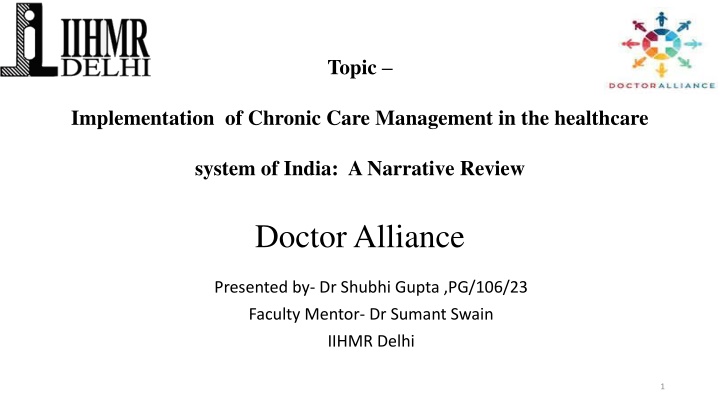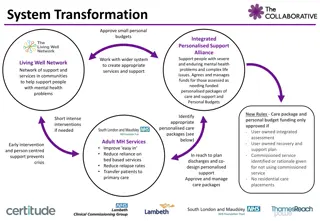Doctor Alliance
This narrative review explores the implementation of Chronic Care Management (CCM) in India's healthcare system, focusing on strategies to enhance patient outcomes, leverage technology, and address challenges in adapting CCM to the Indian context. The study aims to assess the effectiveness and challenges of CCM interventions, providing insights for healthcare improvement.
Download Presentation

Please find below an Image/Link to download the presentation.
The content on the website is provided AS IS for your information and personal use only. It may not be sold, licensed, or shared on other websites without obtaining consent from the author.If you encounter any issues during the download, it is possible that the publisher has removed the file from their server.
You are allowed to download the files provided on this website for personal or commercial use, subject to the condition that they are used lawfully. All files are the property of their respective owners.
The content on the website is provided AS IS for your information and personal use only. It may not be sold, licensed, or shared on other websites without obtaining consent from the author.
E N D
Presentation Transcript
Topic Implementation of Chronic Care Management in the healthcare system of India: A Narrative Review Doctor Alliance Presented by- Dr Shubhi Gupta ,PG/106/23 Faculty Mentor- Dr Sumant Swain IIHMR Delhi 1
Introduction The Chronic Care Management (CCM) program aims to improve the quality of care for patients with chronic conditions by providing coordinated and continuous care. Chronic Care Management (CCM) program aims to improve care for patients with chronic conditions in the USA and has shown promising results. The CCM program implemented in the USA focuses on patient-centered care, care coordination, chronic disease management, and technology utilization. Chronic diseases are a growing burden in India, contributing to increased healthcare costs and reduced quality of life Chronic diseases pose a significant burden in India, contributing to a substantial number of deaths, disability, and healthcare costs. The prevalence of chronic diseases in India, such as cardiovascular disease, diabetes, and cancer, is expected to increase due to factors like urbanization, aging, and lifestyle changes. 3
Introduction Implementing CCM strategies could improve healthcare delivery, patient outcomes, patient engagement, communication and reduce costs in India. Utilizing technology, such as electronic health records and telehealth, can enhance healthcare services, especially in rural areas.. Government initiatives and the digitization of healthcare in India provide opportunities for the adoption and collaboration of future chronic care management strategies Adapting the CCM program to the Indian context and conducting rigorous evaluation and research are necessary for successful implementation and effectiveness. Implementing the CCM program in India could benefit from patient-centered care, care coordination, chronic disease management, technology utilization, and health workforce development. Challenges to implementing the CCM program in India include infrastructure constraints, financial limitations, cultural considerations, healthcare workforce capacity, and variations in the healthcare system. 4
Objectives of the Study GENERAL OBJECTIVE To identify systematically the study of the care of chronic care diseases which could be assessing the effect of implementation of CCM in India. SPECIFIC OBJECTIVES To analyze the extent of those interventions which are featuring the components of the CCM are improving the care of chronic care diseases. To determine the effectiveness which is relative to the various components of the CCM on the care of chronic care diseases. To identify the challenges which are can be faced in implementing the program of the CCM in the health care system of India 5
Research Question Q1. What issues can be faced if the program of the CCM is implemented in the health care system of India? Q2. How could be the CCM applicable if it is applied in the health care system of India? Q3. How the components of the CCM are featured in the inventions of the care of chronic care diseases? Q4. How the components of the CCM in the care of the chronic care diseases are relatively affected with each other? 6
Methodology Relevant studies were identified using databases such as PubMed, Cochrane Library, and Embase. Search terms included Chronic care management," USA healthcare," Indian healthcare," Program implementation," and Chronic care disease , Patient engagement , Patient outcomes , Study Design Narrative Literature Review Inclusion criteria: Studies that are a) published in English, (b) conducted in the USA or India, (c) evaluated the CCM program or similar programs, (d) reported on the merits and shortcomings of the program, and (e) focused on chronic disease management. Exclusion criteria:The exclusion criteria could include studies that are not published in English, studies that focus on acute care management, or studies that do not evaluate the Chronic Care Management program, not conducted in USA & India. Study selection: Screening based on title and abstract, followed by full-text article review for final inclusion. Data extraction: Relevant data from the selected studies were extracted. Data analysis: Synthesis and analysis of the data using a narrative approach classifying results Reporting: The Narrative literature Review results were reported using a structured format, following PRISMA guidelines, in a clear and concise manner.
Methodology Records identifies through database searching Pubmed ( n=206), Scopus (n=118) Embase (n=105) Web of sciences (n=83) Additional records identified from other sources (n=11) Total 512 Duplicates removed (n=237) Records screened (n=286) Records excluded (n=152) Full text articles assessed for eligibility (n=134) A. Population : Not chronic disease B. Setting: Not India or USA (n=19) C. Intervention: Not CCM model D. Outcome: Not relevant (n=16) E. Review / commentary : (n=8) Studies included in final synthesis (n=21) 8
Results Author Country Objective India Methodology Results Balasubramanian, S., Rao, N.M., Goenka, The goal is to look at the rising incidence of chronic illnesses in Descriptive The findings show a rising prevalence of chronic diseases in A., Roderick, M. and Ramanan, A.V., 2020. kids, especially study youngsters, especially diabetes diabetes and heart issues, and to suggest treatment plans for and heart issues, necessitating efficient care techniques. infections that could be fatal. USA Pietrabissa, G., Bertuzzi, V., Giusti, E.M., Examining how the COVID-19 Observation The findings demonstrate that the COVID-19 pandemic has Cattivelli, R. and Castelnuovo, G., 2020 al study hampered access to primary and specialised treatment for epidemic has affected chronic illness management and access people with chronic diseases around the world. to care is the goal of this study. USA Mohanty, S., Venkatarao, E. and Yasobant, The goal is to determine how prepared India is to deal with the Descriptive The findings underscore the difficulties India's healthcare S., 2020 rising incidence of non- communicable illnesses and to study system faces in treating non- communicable diseases, such as improve primary care practises for both prevention and a lack of medical personnel and excessive out-of- pocket treatment. expenses. India Yang, M.C., 2021 The goal is to draw attention to the inequities in chronic care Observation The findings highlight the need for better instruction in al study chronic care management education and to deal with the problems caused management and for healthcare systems around the world to by numerous chronic diseases in healthcare systems. deal with the problems presented by a variety of chronic diseases. India Hazazi, A. and Wilson, A., 2022. By putting the Chronic Care Model (CCM) into practice, the Descriptive The outcomes show the necessity for the Chronic Care goal is to raise the bar for medical care for chronic illnesses. study Model to be implemented in order to enhance medical care for chronic diseases globally. USA Ayanlade, O.S., Oyebisi, T.O. and Kolawole, The purpose of this study was to evaluate the influence of Observation Programmes for chronic care management with B.A., 2019 chronic care management programs on patient outcomes and al study interdisciplinary teams and in-person interactions can lower provide guidance for the creation of healthcare policies and readmission rates and enhance patient outcomes. 9 programs.
Results Results The beneficial chronic diseases and injuries such as cardiovascular disease, psychiatric disorders, diabetes, and cancer are the leading causes of death and disability in India, and the burden of these diseases is expected to increase significantly over the next 25 years Figure 1: Chronic diseases in India It has already been established that only 48 homes overall suffered CHE. Out of these, 41 households (or 85.42% of the households experiencing CHE) have one or more members with a chronic illness. It was discovered that Diabetes Mellitus and Hypertension (70%) were the most prevalent chronic illnesses among CHE-affected households. Longhini et al. 2022). Figure 2: CHE comparison between households with and without chronic illnesses 10
Prevalence of diseases percentage in the population of India About 21% of the elderly in India are reported to keep at small one chronic disease. Seventeen percent of the elderly in rural areas and 29 percent in urban areas suffer from chronic diseases. Hypertension and diabetes account for about 67% of all chronic diseases. Chronic disease prevalence is highest in Kerala (55%), followed by Andhra Pradesh (42%), West Bengal (37%), and Goa (30%) People with higher levels of education,people who live in urban areas, people who are economically dependent on others, people who live alone or have no spouse or children, and people who belong to wealthy families are more likely to be chronically ill an increased risk of developing the disease . You are not allowed to add slides to this presentation 11 Urban residents are 1.15 times more likely to suffer from chronic diseases than rural residents.
Results The significant findings related to chronic disease prevalence, healthcare resources, financial burden, and disparities in access to care. It highlighted the high burden of chronic diseases and associated mental and physical challenges. The study identified limitations in the healthcare system, including limited facilities and healthcare professionals. Additionally, it emphasized the financial burden individuals and families face due to healthcare costs and the disparities in care access, particularly for marginalized populations. . It proposed strengthening the healthcare system in rural areas by increasing facilities, healthcare professionals, and access to essential medical equipment. This study offered a comprehensive analysis of India's chronic healthcare system, providing profound insights into prevalence, challenges, and potential improvements. The findings and recommendations have significant policy improve informed interventions aimed at improving the quality and accessibility of chronic care management in India. 12
Discussion Prevalence and Burden of Chronic Diseases The examination of secondary data and qualitative meetings uncovers a high prevalence and huge burden of chronic diseases in India. Non-transferable diseases like cardiovascular diseases, diabetes, respiratory diseases, and malignant growth are common and add to expanded death rates and diminished personal satisfaction (Thapa et al. 2021). The qualitative data further stress the profound mental burden experienced by people living with chronic diseases, affecting their regular routines and prosperity. Healthcare Framework and Resources The examination features difficulties in healthcare framework and resources. Secondary data examination shows a lack of healthcare offices, especially in provincial regions, prompting restricted access to quality care for people with chronic diseases. The qualitative meetings shed light on the shortage of healthcare professionals, including doctors and subject matter experts, bringing about significant delays and defer in getting fitting care. Moreover, an absence of clinical hardware and fundamental 13 supplies is recognized as a boundary to compelling illness on the board.[Reffreed to Appendix 4]
Discussion Healthcare Expenditure and Financial Burden The examination shows the significant financial burden looked at by people and families because of chronic healthcare costs. Secondary data examination shows high personal expenditures on healthcare, which can prompt horrendous health expenditures and drive families into destitution. The qualitative gatherings give further pieces of information into the money related hardships experienced by individuals, including the need to zero in on healthcare costs over other central necessities and the reliance on easygoing financial empowering gatherings. Considering the revelations and assessment, a couple of policy implications and recommendations emerge. Building up the healthcare system, especially in common districts, is basic to additional creating access to quality care for individuals with chronic diseases. This incorporates expanding the accessibility of healthcare offices, guaranteeing a sufficient number of healthcare professionals, and working on the accessibility of fundamental clinical gear and supplies. 14
Discussion Addressing disparities in access to care requires designated mediations, for example, local area outreach programs, health schooling drives, and further developing transportation framework to work with healthcare access for underestimated populations (Davahli et al. 2020). Also, strategies that advance socially delicate care and oblige customary mending practices can assist with overcoming any issues in healthcare usage among assorted networks. Contract drives ought to likewise zero in on carrying out financial security components, for example, expanding health insurance inclusion and giving appropriations to chronic sickness the board, to ease the financial burden on people and families You are not allowed to add slides to this presentation 15
Conclusion The recommendations focused on the necessity of customizing the CCM program for the Indian setting, strengthening healthcare infrastructure, promoting health literacy and patient education, encouraging multi- sectoral collaboration, aligning policies and reimbursement models, and ensuring ongoing evaluation and improvement. Strategies to enhance financial security, including expanded health insurance coverage and subsidies for chronic disease management, were suggested to alleviate the financial burden. 16
Conclusion Future review and execution can benefit significantly from the examination of the burdens and benefits of the CCM program in the USA, prominently when contrasted with the medical care framework in India. Chronic Care treatment program might be changed and coordinated into the Indian medical services framework, at last working on the therapy of constant illnesses and patient results. The implementation of CCM interventions can be facilitated by spending money on infrastructure development, expanding the capacity of the healthcare framework, and telemedicine access improvements. 17
Conclusion 1. Linking with Objectives Identify systematically the study of the care of chronic care diseases An exhaustive technique for assessing the results of treatments is expected for the deliberate identification and investigation of chronic disease. This procedure contains directing an intensive investigation of relevant examination studies and distributions that look at the therapy and the control of chronic diseases. Investigators can evaluate the impacts of these intercessions on a few features of chronic consideration, including patient results, personal satisfaction, and medical services usage (Rawson et al. 2020) . This calculated philosophy offers smart data about the viability and adequacy of different processes, engaging medical services experts and policymakers to settle on the best therapy plans for chronic diseases. Analyze the extent the CCM is improving the care of chronic care diseases. Efficient assessment can be utilized to decide how much treatments that consolidate the Chronic Care Model parts improve the therapy of chronic diseases. Researchers can assess the impacts of these mediations on a few features of constant consideration, like patient results, the management of diseases, and utilization of medical care, by checking out relevant papers and writing. This examination reveals insight into how well CCM-based mediations act as far as improving the general administration of constant illnesses (Kelly et al. 2019). Understanding the greatness of their effect helps policymakers and medical services experts in measuring the advantages of trying CCM parts and fitting 18 mediations suitably, bringing about superior consideration conveyance andimproved results for individuals with chronic circumstances.
Conclusion To determine the effectiveness which is relative to the various components of the CCM in the care of chronic care diseases Need to implement a model with those elements which are very important on the basis of the relative components which will encourage the care of highly chronic diseases: The system of health, support of self-management, the community, system design of delivery, support of the decision and the system of the clinical information . The most three important components in the case of CCM are trust, mutual respect for each other, and actions that are collaborative and also these are important for improving and also developing the relationship between physicians and patients. The providers of health care and patients must need to share responsibilities and authority with each other. 19
Conclusion Identify the challenges faced in implementing the program of CCM Absence of a satisfactory medical care framework Resource restrictions, Boundaries could likewise be brought about by semantic variety, social contrasts, and the necessity for patient and supplier instruction (Sarrafzadegan et al. 2019). It will be fundamental to change the CCM program for the Indian setting, considering financial imbalances and coordinating it with the ongoing medical care framework. To guarantee advantageous execution and amplify the program s likely benefits for upgrading constant consideration in India, these obstacles should be survived. This needs collaboration among partners, strategy support, and centered mediation 20
REFERENCES 21
REFERENCES 22
REFERENCES 23
Thank You Any Questions 24
Pictorial Journey (1/2) Pictorial Journey (1/2) 25
Pictorial Journey (2/2) Pictorial Journey (2/2) 26























